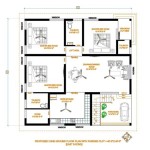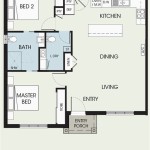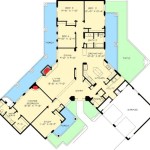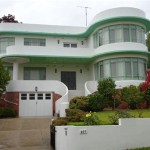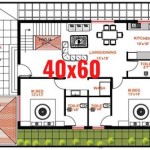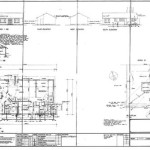Exploring 1-Bedroom Apartment Floor Plans: Maximizing Space and Functionality
One-bedroom apartments are a common housing choice for individuals, couples, and those seeking a more manageable living space. The popularity of these units stems from their affordability, lower maintenance requirements, and accessibility in urban and suburban areas. Successful living in a one-bedroom apartment hinges on the effective utilization of space, and the key to this lies in understanding and optimizing various floor plan designs. Selecting the right floor plan can significantly impact quality of life, influencing factors such as convenience, comfort, and overall satisfaction with the living environment.
This article will delve into various aspects of 1-bedroom apartment floor plans, providing insights into common layouts, design considerations, and strategies for maximizing space. We will explore different floor plan types, discuss the advantages and disadvantages of each, and offer practical tips for furnishing and organizing a one-bedroom apartment to create a functional and aesthetically pleasing living space.
Defining the Essential Components of a 1-Bedroom Apartment
A standard one-bedroom apartment comprises several key areas: the bedroom, living room, kitchen, bathroom, and potentially a dining area or additional storage space. Each of these components plays a vital role in the overall functionality of the apartment. The bedroom serves as a private sanctuary for rest and relaxation. The living room functions as a central hub for entertainment, socializing, and leisure activities. The kitchen is dedicated to food preparation and storage. The bathroom provides essential hygiene facilities. The arrangement and size of these areas within the floor plan dictate the flow of movement and the usability of the space.
The size of a one-bedroom apartment can vary considerably, ranging from a compact 500 square feet to a more spacious 1000 square feet or more. Square footage directly impacts the versatility and potential for customization. A larger apartment offers more flexibility in furniture arrangement and allows for designated zones for different activities, while a smaller apartment necessitates more strategic planning and space-saving solutions.
Beyond the core components, other features can influence the appeal and functionality of a one-bedroom apartment. These include the presence of a balcony or patio, in-unit laundry facilities, ample closet space, and natural light sources. These amenities contribute to the overall comfort and convenience of the living environment.
Common 1-Bedroom Apartment Floor Plan Types
Several popular floor plan types cater to the unique needs and preferences of different individuals. Each layout offers its own advantages and disadvantages in terms of space utilization, privacy, and flow.
The Linear Layout: This is one of the most common types, especially in older buildings, and features a straightforward, rectangular design where each room is arranged in a linear fashion along a single hallway. The entrance typically leads into the living room, which may be connected to the kitchen. The bedroom is usually located at the end of the hallway, and the bathroom is situated either near the bedroom or closer to the entrance. This layout is generally efficient in terms of space utilization, but can feel somewhat confined if the hallway is narrow or the rooms are small. Privacy can also be a concern if the bedroom door opens directly into the living room.
The Open-Concept Layout: This design emphasizes a seamless flow between the living room and kitchen, creating a larger, more airy feel. The kitchen is often integrated into the living area, separated by a breakfast bar or island. This layout is ideal for individuals who enjoy entertaining or prefer a more modern and spacious living environment. However, it can offer less privacy and may require careful planning to define distinct zones within the open space. Noise from the kitchen can also be a consideration.
The L-Shaped Layout: This design features the living room and kitchen forming an "L" shape, with the bedroom and bathroom located in a separate wing. This layout provides a greater sense of privacy for the bedroom and creates a natural separation between the living and sleeping areas. It also offers good flow and can be easily adapted to different furniture arrangements. However, the L-shape can sometimes result in awkward corners or wasted space.
The Loft-Style Layout: Typically found in converted industrial buildings, loft-style apartments feature high ceilings, exposed brick, and large windows. The living and sleeping areas are often combined into a single open space, with the bathroom and kitchen located in separate areas. This layout offers a unique and spacious living environment, but requires careful planning to define distinct zones and maintain privacy. Storage can also be a challenge in loft-style apartments.
The Split-Level Layout: In this design, the living room and bedroom are located on different levels, connected by a short flight of stairs. This layout creates a sense of separation and privacy, but can be challenging for individuals with mobility issues. It also requires careful consideration of lighting and decor to ensure a cohesive and welcoming atmosphere. This layout is less common than the others.
Strategies for Maximizing Space in a 1-Bedroom Apartment
Regardless of the chosen floor plan, maximizing space is crucial for comfortable living in a one-bedroom apartment. Several strategies can be employed to create a more spacious and functional living environment.
Furniture Selection: Choosing furniture that is appropriately sized for the apartment is essential. Avoid oversized furniture that can overwhelm the space and restrict movement. Opt for multi-functional pieces, such as a sofa bed for accommodating guests or a coffee table with built-in storage. Consider vertical storage solutions, such as bookshelves that reach the ceiling, to maximize storage space without occupying too much floor area. Wall-mounted shelves are also excellent space savers.
Organization and Decluttering: Keeping the apartment organized and clutter-free is paramount. Regularly decluttering unnecessary items and implementing effective storage solutions can significantly enhance the sense of space and order. Utilize storage containers, baskets, and organizers to keep belongings neatly stored and out of sight. Consider donating or selling items that are no longer needed or used.
Lighting: Adequate lighting can dramatically impact the perceived size and atmosphere of an apartment. Maximize natural light by keeping windows clean and unobstructed. Supplement natural light with a combination of ambient, task, and accent lighting. Mirrors can also be strategically placed to reflect light and create the illusion of more space. Light-colored walls and furnishings can also help to brighten the apartment and make it feel more open.
Vertical Space Utilization: Exploiting vertical space is a crucial strategy for maximizing storage and creating visual interest. Install shelves above doorways, utilize tall bookcases, and consider hanging storage solutions. Vertical gardens can also add a touch of greenery and visual appeal to the apartment. Consider using wall-mounted bike racks to save floor space if cycling is a hobby.
Defining Zones: In open-concept layouts, it is important to define distinct zones for different activities. This can be achieved through the use of area rugs, furniture placement, or room dividers. For example, a large area rug can delineate the living room area, while a bookcase can serve as a partition between the living room and dining area. These zones help to create a sense of order and organization within the open space.
Color Palette: The color palette can significantly impact the perceived size and atmosphere of the apartment. Light and neutral colors tend to make spaces feel larger and more open, while darker colors can make them feel smaller and more enclosed. Consider using a cohesive color scheme throughout the apartment to create a sense of harmony and flow. Accent colors can be used to add pops of visual interest and personality.
Wall Decor: Choosing the right wall decor can enhance the aesthetic appeal of the apartment without overwhelming the space. Opt for minimalist art pieces or small groupings of artwork. Avoid overcrowding the walls with too many items. Mirrors can also be used to create the illusion of more space and reflect light. Floating shelves can display decorative items without taking up floor space.
Multi-functional Furniture: As previously mentioned, selecting multi-functional furniture is key to maximizing space. Sofa beds provide extra sleeping space for guests, while storage ottomans offer both seating and storage. Coffee tables with lift-top mechanisms can transform into dining tables or work surfaces. These types of furniture pieces are invaluable for optimizing space in a small apartment.
Clear Pathways: Ensure that there are clear pathways throughout the apartment to avoid creating a cluttered and cramped feeling. Arrange furniture in a way that allows for easy movement and flow. Avoid placing furniture in doorways or walkways. A clear and unobstructed pathway will make the apartment feel more open and inviting.
Consider a Murphy Bed: Though a more significant investment, a Murphy bed (also known as a wall bed) can transform a one-bedroom apartment. During the day, it folds up into the wall, creating a larger living space. At night, it easily folds down for sleep. This is particularly useful for smaller apartments or those that need to double as a home office.
By implementing these strategies, individuals can effectively maximize space in a one-bedroom apartment and create a comfortable, functional, and aesthetically pleasing living environment. Careful planning, strategic furniture selection, and effective organization are key to transforming a small space into a welcoming home.

1 Bedroom Apartment Floor Plans 500 Sf Du Apartments Rates Aspen Gate Apart Small

1 Bedroom Apartment Plan Examples

One Bedroom Standard Floor Plan Apartments In M Massachusetts Princeton Crossing

Floor Plans The Central Apartments

Selecting The Right Apartment Floor Plans Apartments For In Heights Houston

1 Bedroom Apartment Plan Examples

1 Bedroom Apartment Plan Examples

Free Editable Apartment Floor Plans Edrawmax

Studio Floor Plans Apartment Small Layout

Modern One Bedroom 3d Floor Plans Tsymbals Design

